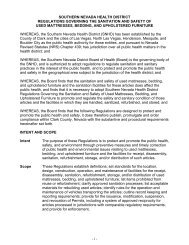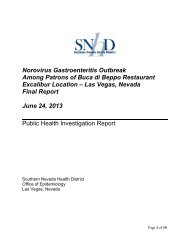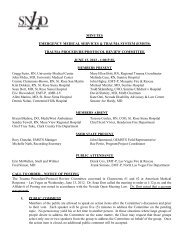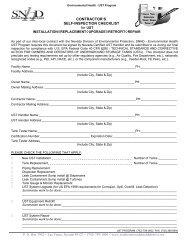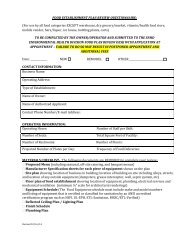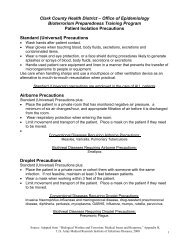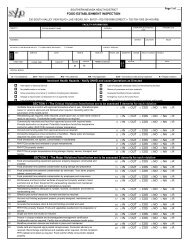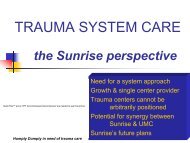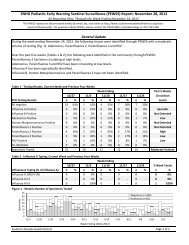Current Trauma Status Report - Southern Nevada Health District
Current Trauma Status Report - Southern Nevada Health District
Current Trauma Status Report - Southern Nevada Health District
Create successful ePaper yourself
Turn your PDF publications into a flip-book with our unique Google optimized e-Paper software.
Clark County <strong>Health</strong> <strong>District</strong> has identified a significant problem with drownings of children aged 1 - 4,<br />
motor vehicle crashes and suicides. All three high-risk groups have prevention programs in place that<br />
were identified through data screening processes using various existing databases.<br />
Evaluation<br />
The Clark County <strong>Health</strong> <strong>District</strong> is responsible for the prehospital component of care in Clark County<br />
and the <strong>Nevada</strong> State <strong>Health</strong> Division’s EMS section has the responsibility of overseeing trauma.<br />
There are mechanisms in place for evaluation of trauma in <strong>Southern</strong> <strong>Nevada</strong> that include the ACS<br />
verification process UMC must complete every three years, the EMS training requirements set forth in<br />
state law, and the oversight provided by the Medical Advisory Board (members of the MAB are<br />
representatives from all hospitals, prehospital providers, the <strong>Nevada</strong> Division of Mental <strong>Health</strong> and<br />
Development Services, and the Clark County <strong>Health</strong> <strong>District</strong>).<br />
There is no overall quality improvement committee for the current trauma program. However, UMC<br />
does have a trauma center focused quality improvement committee that meets weekly. The UMC<br />
quality improvement committee focuses on deaths and other serious adverse events. All deaths are<br />
reviewed by the trauma center peer review/performance improvement committee and if necessary are<br />
presented to a monthly multidisciplinary committee at UMC, then to the hospital performance<br />
improvement committee. If the case involves a prehospital component, then it is forwarded to the<br />
Clark County <strong>Health</strong> <strong>District</strong> EMS Department. The UMC trauma registry is used to help direct process<br />
improvement by reviewing data generated from the registry. For example, trauma treatment protocols<br />
have been developed based on identified trends in the trauma registry and recommendations for the<br />
trauma activation criteria have been made based on data contained in the trauma registry. In addition<br />
to the oversight provided by UMC, the MAB provides oversight for the EMS portion of trauma.<br />
Research<br />
UMC conducts a vast amount of research as part of its level I trauma center requirements. Their<br />
trauma registry is used to research topics identified by surgery residents, resulting in numerous<br />
posters and presentations. In addition, the surgery residents participate in the ACS Committee on<br />
<strong>Trauma</strong> annual Residents <strong>Trauma</strong> Paper Competition.<br />
Another significant research entity of trauma in <strong>Southern</strong> <strong>Nevada</strong> is the <strong>Trauma</strong> Institute, which was<br />
established with private funding in 1997. The <strong>Trauma</strong> Institute obtains its data from several sources.<br />
Its primary source is the Uniform Billing 92 Hospital Discharge data set collected by the <strong>Nevada</strong> State<br />
<strong>Health</strong> Division. The <strong>Trauma</strong> Institute also has a working agreement with a local EMS transport<br />
agency to obtain prehospital data. Funding for the <strong>Trauma</strong> Institute is obtained via grant funding from<br />
several entities including: the National Highway Transportation Safety Administration (NHTSA),<br />
<strong>Nevada</strong> Attorney General’s Office, Centers for Disease Control, <strong>Health</strong> Resources and Services<br />
Administration (HRSA), and Emergency Medical Services for Children (EMSC). The <strong>Trauma</strong> Institute<br />
also receives private funding.<br />
Page 58



